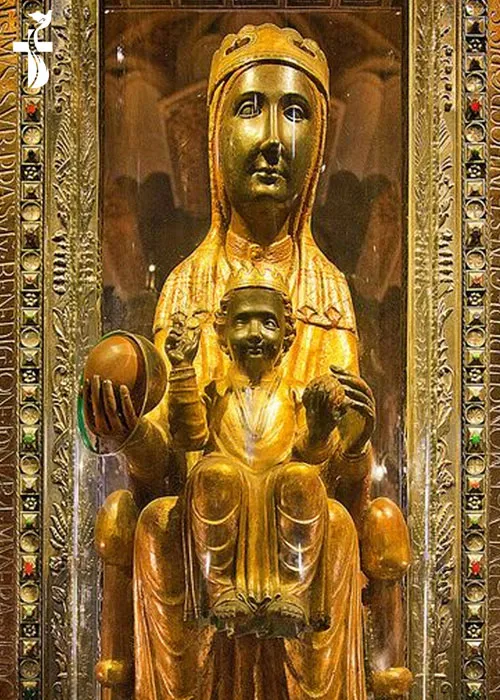
Our Lady Of La Moreneta
Country : Spain
Year :
The one and only “Lady of Spain” is a black Madonna who reigns from the lofty heights of Montserrat. The Virgin smiles down from her place of honor above the main altar of the Basilica of Montserrat. La Moreneta means the “Little Black One”. The statue is four feet high and made of wood, blackened from the smoke of innumerable candles which have burned before her through the ages. She is seated upon a chair and holds her Divine Child who has a fir apple in His left hand. Our Queen is clothed in a golden mantle, a tunic and a veil of diverse colors; the Infant wears a simple tunic, and He and His Mother wear matching wooden crowns. The miraculous statue reposes upon a gleaming throne of marble, and over all, the sunlight diffuses glow.
The origin of the statue and the manner in which it first came to a lowly grotto in the mountain side is not known, but is told by an uninterrupted folklore describing its descent from heaven. The legends date from the 9th century when it is believed the hermits who dwelt in caves kept watch over a tiny chapel known as Santa Maria de Montserrat. Reliable documents have it that a great monastic center was founded among the same cliffs in the 11th century and that a small black statue of the Madonna drew the kings of Aragon, the monarchs of Spain, Emperor Charles V, saints, and celebrities, as well as common folks to the difficult mountain. Here arduous pilgrimages terminated, and here wondrous miracles were wrought. As the fame of La Moreneta spread her original chapel underwent many transformations before the basilica was constructed in the 16th century. Now the first chapel is called the “Holy Grotto” and is decorated within with marble, fine tapestries, and two altars; one to St. Scholastica, the other to St. Benedict so that Mass can be said on feast days and other special occasions.
Montserrat or “Saw-tooth Mountain” which Our Lady chose for her shrine is believed to have an intrinsic holiness. Its highest peak bears the name. Tradition says this is the place the devil took Christ after His forty days’ fast; there is possibility of this being true. Legend further says it was the sight of the Holy Grail in Wagner’s opera “Parsifal”. The mountain of the shrine is 4,070 feet high, multicolored and interspersed with lush patches of tropical vegetation.



